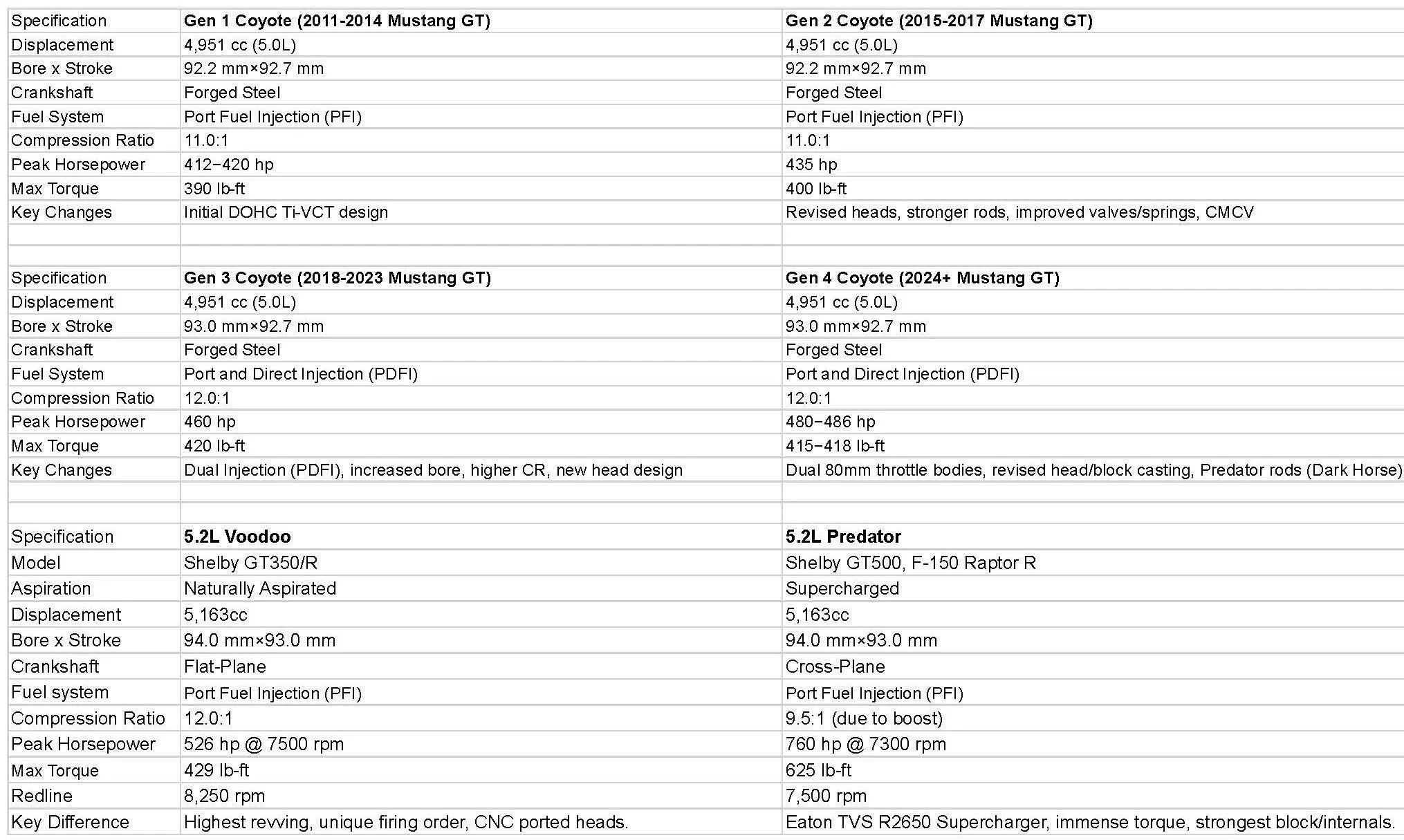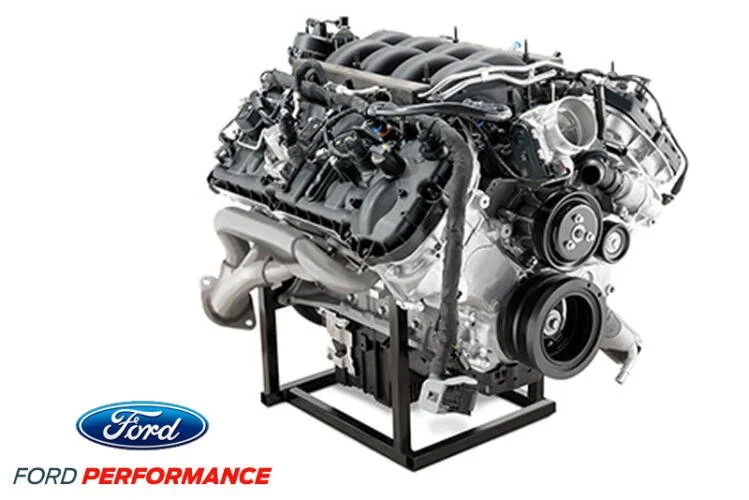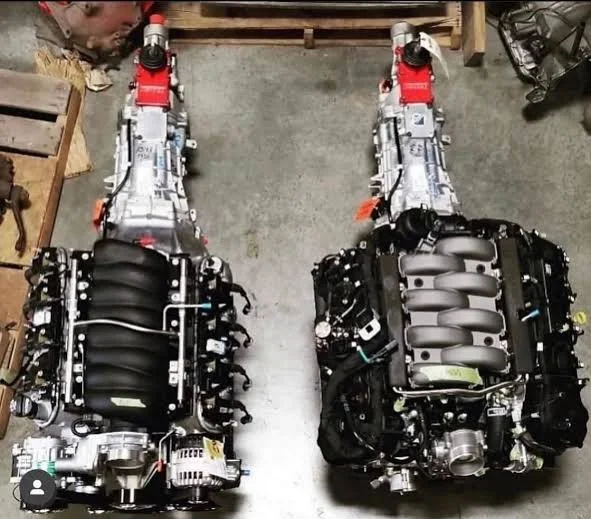Engine-pedia: everything awesome about Ford’s 5.0L Coyote, & 5.2L Voodoo & predator V8s
The introduction of the "Coyote" 5.0-litre V8 engine in 2011 marked a watershed moment for Ford, establishing a fresh, advanced successor to the Mod Motor V8 family that had shifted the Blue Oval away from pushrod power in the 90s. These new-age 302s have nothing in common with the old school Windsor pushrod V8s which share the displacement, but better was to come with the high-performance 5.2-litre variants: the high-revving "Voodoo" with its flat-plane crank, and the epic 760hp supercharged "Predator".
While the engine has maintained many core spes, it has evolved greatly since it debuted back in 2011, as can be seen below with the various generations broken down.
The Coyote engine is characterised by its all-aluminum construction, 4951cc capacity, dual overhead camshaft (DOHC) heads, nominally high compression ratio, and the advanced Twin Independent Variable Camshaft Timing (Ti-VCT). Refinements in fuelling from switching to direct-injection with the Gen 3 Coyote has been one of the largest drivers of the jump in power from the original Coyote’s 412hp to the 2025 version’s 486hp.
The foundational Coyote was in production 2011-2014 and featured an aluminum block with press-in cast iron cylinder liners. It utilised a cross-bolted 6-bolt main bearing design and was equipped with a robust forged-steel crankshaft. The key feature was the Ti-VCT system on both intake and exhaust camshafts, allowing for superior tuning and broad torque characteristics. When the Gen 2 ‘Yote launched in 2015 Ford had concentrated on refining power and high-RPM stability. Upgrades included revised cylinder heads based on the Boss 302 design, stiffer valve springs, and a new intake manifold utilising control valves (CMCV), which improved low-end torque by inducing swirl in the air charge at low engine speeds.
The third-generation Coyote landed in 2018 and signalled a quantum leap with its change from port-injection to dual-injection, incorporating both port- and direct-injection. Direct injection was crucial for allowing the 12.0:1 compression ratio while managing knock control, while port-injection maintained excellent idle quality and low-speed emissions. The Gen 3 Coyote also moved to a plasma transferred wire arc spray-in cylinder liner technology instead of iron sleeves. This allowed for a larger bore and lighter block.
Launched in 2024 the latest iteration of the Coyote 5.0 features a twin 80mm throttle bodies for improved airflow, while the performance-focused Dark Horse Mustang is notable for using stronger con rods derived from the 760hp supercharged 5.2L Predator engine, enhancing its durability for track use.
The chart below shows the weights and dimensions of both the 5.0L Coyote and 5.2L variants, with the single largest drawback of this platform plain to see: the 736mm (29in) width across the engine thanks to those high-flowing DOHC heads. It is important to note how tall the 5.2L Predator V8 stands at 812mm, thanks to the Eaton 2650cc supercharger and intercooler which will make packaging an issue in low-slung classic cars.
The 5.2L V8 Outliers: Voodoo and Predator
The 5.2L engines are highly specialised variants of the Coyote architecture, primarily used in limited-production Shelby models, inclucing the track-focused GT350 (Voodoo) and GT500 (Predator) which is the often regarded as the most powerful Ford production car outside the GT (GT40).
The 5.2L Voodoo is a 526hp technological tour-de-force, utilising a flat-plane crankshaft (a 180-degree crank) that results in a unique exhaust note and allows for a stratospheric 8,250 rpm redline. The larger bore is achieved using the same plasma spray-in liner technology as the later Coyote generations.
Ford sell an aftermarket version of the Voodoo engine as the 5.2 Aluminator, though it uses a traditional cross-plane crankshaft for reliability concerns after the Voodoo suffered warranty claims for damage stemming from the flat-plane crank layout.
The 5.2L Predator also uses a more traditional cross-plane crankshaft, but features a massive Eaton TVS2650 supercharger and internals upgraded to suit the boosted application. This engine is built with a reinforced aluminum block, robust forged steel internals (crank, rods, and pistons), and a lower compression ratio to handle the extreme cylinder pressures of forced induction.
The most powerful Ford production engine sold at the time, the 760hp Predator V8 was offered in late-model S550 GT500 Shelby Mustangs, but could also be ordered as a crate motor from Ford Performance.
The Coyote and Voodoo blocks are incredibly light for their power output, which is a major advantage for vehicle handling. The weight difference between the Coyote and Voodoo is minimal, driven mainly by the larger bore. The Predator engine's weight increase is largely attributable to the heavy Eaton2.65L supercharger and intercooler assembly mounted atop the engine, and its more robust components.
Ultimately these engines have been limited in their aftermarket engine-swap applications due to their sheer size and the entry price to buy them. All that technology comes at a price, and these engines it takes someone really on the train for the Coyote to spend far more money buying an engine that makes similar power to one which is much easier to fit (ie: the LS3). Have a look at the image below to get the clearest visual indicator of why the Coyote struggles against the LS.
Despite these hurdles punters are finally cottoning onto how well-engineered the Coyote is, and the performance potential of Ford’s modern 5.0 and 5.2L V8s. Thanks to people like Brett Lasala and the Snot Rocket Mustang people are really cottoning onto how potent a platform the Coyote is: 6.24@227mph from a street-driven Mustang is no joke.







